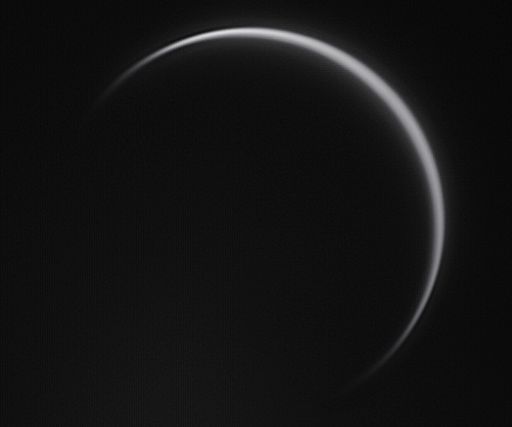Learn to photograph Northern Lights like a pro. Sign up for Peter Rosen's Aurora Photo Courses in Abisko National Park, winner of the TripAdvisor Certificate of Excellence Award 2015. | | |
STRANGELY QUIET: Directly facing Earth, sunspot AR2396 is big and apparently potent. Yet for the fifth day in a row, it is strangely quiet. NOAA forecasters estimate a 35% chance of M-class solar flares on Aug. 9th. If current trends continue, however, solar activity will remain low. Solar flare alerts: text or voice.
EARTH IS CROSSING TWO COMET DEBRIS STREAMS: The Canadian Meteor Orbit Radar (CMOR) is scanning the skies above North America for echoes from disintegrating meteoroids. There are plenty of echoes to detect. The latest CMOR sky map shows two active radiants in the night sky--one associated with the Perseid meteor shower (PER) and another with the Southern Delta Aquarids (SDA):

Perseids come from 109P/Swift-Tuttle, a large comet with a rich debris stream. The shower is expected to peak this year on August 12-13 with as many as 100+ meteors per hour. Of all the meteor showers of the year, the Perseids produce the most fireballs.
While we are waiting for the Perseids to peak, the Southern Delta Aquarid meteor shower is making its own contribution. Caused by debris from an ancient sungrazing comet, this shower produces 10 to 20 meteors per hour every year in late July and early August. Southern Delta Aquarid meteors are not as bright as their Perseid counterparts, but they are visible.
Earth's simultaneous interaction with these two debris streams should keep the meteor rate elevated for the entire week ahead. Be alert for flashes of light in the night sky--and stay tuned!
Realtime Space Weather Photo Gallery
A SLIVER OF VENUS: On August 15th, Venus will pass almost directly between Earth and the sun--an event astronomers call "inferior solar conjunction." As Venus approaches the sun, the planet is turning its night side toward Earth, reducing its luminous glow to a thin sliver. Damian Peach sends this image of the narrowing crescent from his private observatory in Selsey, UK:

In the days ahead, the crescent of Venus will become increasingly thin and circular. The horns of the crescent might actually touch when the Venus-sun angle is least on August 15th (7.9o). This is arguably the most beautiful time to observe Venus--but also the most perilous. The glare of the nearby sun magnified by a telescope can damage the eyes of anyone looking through the eyepiece.
Anthony J. Cook of the Griffith Observatory has some advice for observers: "I have observed Venus at conjunction, but only from within the shadow of a building, or by adding a mask to the front end of the telescope to fully shadow the optics from direct sunlight. This is tricky with a refractor or a catadioptric, because the optics start at the front end of the tube. Here at Griffith Observatory, I rotate the telescope dome to make sure the lens of the telescope is shaded from direct sunlight, even through it means that the lens will be partially blocked when aimed at Venus. With our Newtonian telescope, I add a curved cardboard mask at the front end of the tube to shadow the primary mirror."
Potential observers should take precautions as outlined above. That said, if you have a GOTO telescope, command it to slew to Venus this evening. The slender cresent is only 12o from the sun on Aug. 8th, and it's a beauty!
Realtime Venus Photo Gallery
Realtime Aurora Photo Gallery
Realtime Sprite Photo Gallery
Realtime NLC Photo Gallery
Every night, a network of NASA all-sky cameras scans the skies above the United States for meteoritic fireballs. Automated software maintained by NASA's Meteoroid Environment Office calculates their orbits, velocity, penetration depth in Earth's atmosphere and many other characteristics. Daily results are presented here on Spaceweather.com.
On Aug. 9, 2015, the network reported 42 fireballs.
(21 Perseids, 20 sporadics, 1 Northern delta Aquariid)

In this diagram of the inner solar system, all of the fireball orbits intersect at a single point--Earth. The orbits are color-coded by velocity, from slow (red) to fast (blue). [Larger image] [movies]
Potentially Hazardous Asteroids (
PHAs) are space rocks larger than approximately 100m that can come closer to Earth than 0.05 AU. None of the known PHAs is on a collision course with our planet, although astronomers are finding
new ones all the time.
On August 9, 2015 there were potentially hazardous asteroids.
Notes: LD means "Lunar Distance." 1 LD = 384,401 km, the distance between Earth and the Moon. 1 LD also equals 0.00256 AU. MAG is the visual magnitude of the asteroid on the date of closest approach. | | The official U.S. government space weather bureau |
| | The first place to look for information about sundogs, pillars, rainbows and related phenomena. |
| | Researchers call it a "Hubble for the sun." SDO is the most advanced solar observatory ever. |
| | 3D views of the sun from NASA's Solar and Terrestrial Relations Observatory |
| | Realtime and archival images of the Sun from SOHO. |
| | from the NOAA Space Environment Center |
| | the underlying science of space weather |
| | Web-based high school science course with free enrollment |

